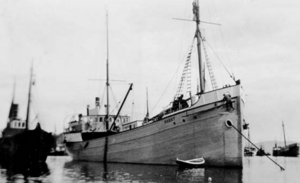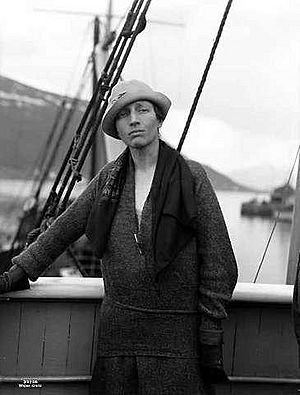Louise Boyd facts for kids
Louise Arner Boyd (born September 16, 1887 – died September 14, 1972) was a brave American explorer. She explored Greenland and the Arctic regions. Louise wrote many books about her scientific trips. In 1955, she became the first woman to fly over the North Pole. She hired a special plane, a DC-4, and its crew for this amazing flight.
Contents
Early Life and Adventures
Louise Arner Boyd was born in San Rafael, California. Her father, John Franklin Boyd, owned part of a gold mine. Her mother was Louise Cook Arner. Louise grew up in Marin County and the hills of Oakland. She had two older brothers, Seth and John. They had a fun and easy childhood.
Every summer, the family stayed at their ranch in the Oakland Hills. Here, Louise and her brothers rode horses and explored Mount Diablo. They also fished, hunted, and camped. They lived a very adventurous life outdoors.
The Boyd family was quite wealthy. This allowed their children to get a great education. When Louise was a teenager, both of her brothers sadly died. They passed away from heart disease, which was caused by rheumatic fever when they were younger. Her parents were very sad and relied on Louise for comfort.
After her brothers died, Louise traveled a lot with her parents. They took many trips to Europe. During this time, she became very interested in photography. In 1919 and 1920, her parents passed away. Louise then inherited the family's large fortune.
Amazing Expeditions

In 1919, Louise took a train to Buffalo, New York. She bought a car and, with her driver, drove across the United States. This was a huge challenge because there were no highways then. Roads were often just gravel and dirt. This was the first of many cross-country trips she would take and write about.
She started traveling more in the early 1920s. In 1924, she visited Norway. While there, she sailed out to sea and saw the Polar Ice Pack for the first time. This experience changed her life. She immediately started planning her own Arctic adventure.
In 1926, she rented a supply ship called the Hobby. This ship had been used by the famous Arctic explorer Roald Amundsen. Louise used it for a hunting and filming trip to the Arctic. Her friends, the Count and Countess Ribadavia, joined her.
Searching for Roald Amundsen
In 1928, Louise was planning another trip on the Hobby. Then, she heard that the famous Norwegian explorer Roald Amundsen was missing. He had gone to search for another explorer, Umberto Nobile, whose balloon expedition had disappeared in the Arctic. Louise offered her ship and help to the Norwegian government. She said, “How could I go on a pleasure trip when those 22 lives were at stake?”
She traveled about 10,000 miles (16,100 km) across the Arctic Ocean. But she found no sign of Amundsen. Even so, the Norwegian government gave her a special award. It was the Chevalier Cross of the Order of Saint Olav. She was the first American woman to receive this honor.
Exploring Greenland
In the 1930s, Boyd led many scientific trips to the east and north coasts of Greenland. Louise took photos, surveyed the land, and collected hundreds of plant samples. She learned a lot from her friend, Alice Eastwood, who worked at the California Academy of Sciences.
The American Geographical Society published her findings and photos from her 1933 and 1935 trips. The book was called The Fiord Region of East Greenland. Later, an area near the Gerard de Geer Glacier was named Louise Boyd Land in her honor. For her leadership and science work, Ms. Boyd received the important Cullum Medal in 1938.
Journey Across Poland
In August 1934, Louise was chosen to represent her country at a big meeting. It was the International Geographical Congress in Warsaw, Poland. After the meeting, Louise began a three-month journey across the Polish countryside. She took photos and wrote about the customs, clothes, economy, and culture of the people. These included Poles, Ukrainians, Byelorussians, and Lithuanians.
She traveled by car, train, boat, and on foot. Her journey took her through towns like Lviv and Kovel (now in Ukraine). Then she went to Kobrin, Pinsk, Kletsk, Nesvizh, and Slonim (now in Belarus). She finished her trip in Vilno. Her travel story, with over 500 photos, was published in 1937. It was called Polish Countrysides.
Helping the U.S. Government
When World War II started, Louise's knowledge of Greenland and the Arctic became very important. The United States government asked her not to publish a book she was writing. Instead, they asked her to lead a special trip. This trip was for the Department of Commerce National Bureau of Standards. She would explore the west coast of Greenland and the coasts of Baffin Island and Labrador.
Louise paid for the ship and its supplies herself. She rented the schooner Effie M. Morrissey. This ship, led by Captain Robert Bartlett, had been on many successful science trips to the Arctic since 1926.
The main goal of the 1941 trip was to gather information about radio waves in the Arctic. They studied the ionosphere, Earth's magnetic field, and the aurorae (Northern Lights). The Effie M. Morrissey sailed from Washington D.C. on June 11, 1941. Louise Boyd led a team of four scientists and a crew of eleven. The trip ended on November 3, 1941, and they brought back valuable information.
During the rest of the war, Boyd worked on secret projects for the U.S. Department of the Army. In 1949, she received a special award from the Army. Her book, The Coast of Northeast Greenland, which had been held back, was finally published in 1948.
Louise Boyd's Thoughts
- “The Arctic is truly charming. It is so diverse and separate from the rest of the world. It gives its own reward. Only those who have seen the amazing sunsets over the ice, or been caught in storms, can understand why we always want to go back.”
- “I enjoy the nice things most women like. Even if I wear pants and boots on a trip, and sometimes sleep in them, I still powder my nose before going on deck, no matter how rough the sea is.”
Later Years and Legacy
Louise Arner Boyd never married or had children. Later in her life, she was a well-known person in Marin. She was also a hostess and a member of the San Francisco Symphony Orchestra's committee.
Towards the end of her life, Louise faced money problems. She had spent a lot of her fortune on her many explorations. She eventually had to sell her family home, Maple Lawn, in San Rafael. She then lived permanently in San Francisco.
Louise died in San Francisco on September 14, 1972. She passed away just two days before her 85th birthday.
Interesting Facts About Louise Boyd
- Her parents gave their old gatehouse and some family land to the City of San Rafael. This was a memorial to their two sons and is now called Boyd Park.
- The Victorian-style building that belonged to the Boyds is now the Marin History Museum.
- In 1925, she was introduced to the King and Queen of England. This was a rare honor for an American woman.
- She became famous around the world for her adventures and for hunting polar bears. Newspapers called her the “Arctic Diana” and “The Girl Who Tamed the Arctic.”
- The Count of Ribadavia published a book in 1927 with Louise's photos. It was called Chasses Et Aventures Dans Les Regions Polaires (Hunting and Adventures in the Polar Regions).
- She worked as a consultant for the Department of Commerce National Bureau of Standards for a very small salary of one dollar a year.
Awards and Honors
- The Chevalier Cross of the Order of Saint Olav, from the Norwegian government.
- In 1938, she received the important Cullum Medal from the American Geographical Society (AGS).
- In 1949, she was given a Department of Army Certificate of Appreciation.
- She received honorary law degrees from the University of California, Berkeley, and from Mills College.
- In 1960, Louise was the first woman elected to the board of the American Geographical Society.
- She was also made an honorary member of the California Academy of Science.
See also
Images for kids




